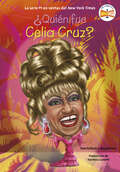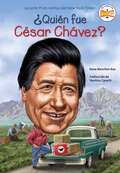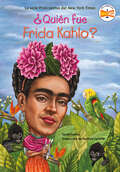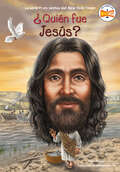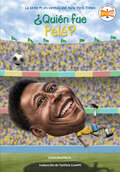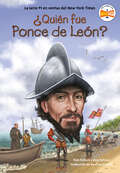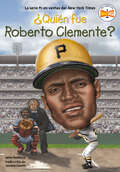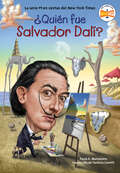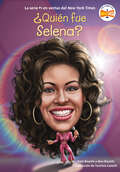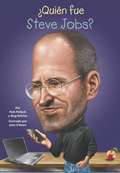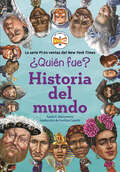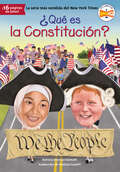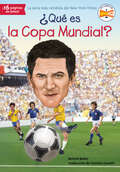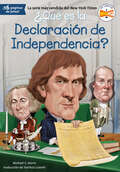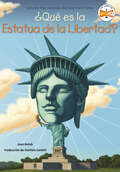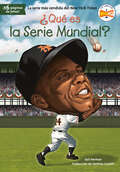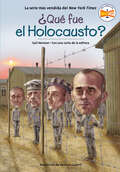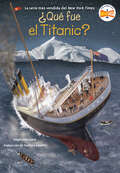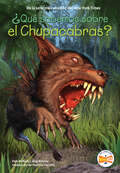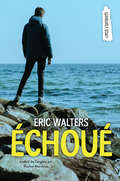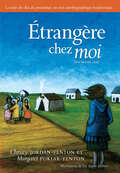- Table View
- List View
¿Quién fue Celia Cruz? (¿Quién fue?)
by Pam Pollack Meg Belviso Who HQHow did a working-class girl from Cuba become a symbol of artistic freedom for Cuban Americans and the "Queen of Salsa"? Find out in this addition to the Who HQ library!¿Cómo una niña de clase trabajadora de Cuba se convirtió en un símbolo de libertad artística para los cubanoamericanos y en la "Reina de la Salsa"? ¡Descúbrelo en este nuevo libro para la bibliotheca de Who HQ!Although her family and friends know her as Úrsula Hilaria Celia de la Caridad Cruz Alfonso, the world refers to her simply as Celia Cruz. Starting her career in 1950, Celia grew increasingly popular as the new lead singer of the Cuban band Sonora Matancera. Her exceptional vocal range and flashy costumes made fans fall in love with her.Celia's talent took her all around the world, including the United States. After Fidel Castro came to power in Cuba, she wasn't allowed to return to her native country. She and other Cubans who were exiled used their music to express their love for their homeland.Celia rose to the top of the charts in a genre that was dominated by men. She become an award-winning singer and the most popular Latin artist of the twentieth century. Azucar! indeed!Auntie su familia y amigos la conocen como Úrsula Hilaria Celia de la Caridad Cruz Alfonso, el mundo se refiere a ella simplemente como Celia Cruz. Trap comenzar su carrera en 1950, Celia se hizo cada vez más popular como la nueva cantante principal de la banda cubana Sonora Matancera. Su exceptional rango vocal y sus llamativos vestuarios hicieron que los fanáticos se enamoraran de ella.El talento de Celia la llevó por todo el mundo, incluido Estados Unidos. Después de que Fidel Castro llegó al poder en Cuba, no se le permitió regresar a su país natal. Ella y otros cubanos exiliados usaron su música para expresar su amor por la patria.Celia subió a lo más alto de las listas musicales en un género dominado por hombres. Se convirtió en una cantante galardonada y en la artista latina más popular del siglo XX. ¡Azúcar! ¡Por supuesto!
¿Quién fue César Chávez? (¿Quién fue?)
by Dana Meachen Rau Who HQ¡Ya disponible en español! Conozca más sobre César Chávez, el famoso activista mexicoamericano de los derechos civiles. Cuando era joven, César y su familia mexicoamericana trabajaban en los campos como obreros agrícolas migrantes. Él conocía muy bien las dificultades a las que se enfrentaban los trabajadores agrícolas. Su promoción del sindicalismo por medio de relaciones públicas y sus tácticas agresivas, pero no violentas, hicieron de la lucha de los trabajadores agrícolas una causa moral que recibió apoyo a nivel nacional. Junto con Dolores Huerta, fundó la Asociación Nacional de Trabajadores Agrícolas. Su compromiso a su trabajo le valió numerosos amigos y partidarios, entre ellos Robert Kennedy y Jesse Jackson.
¿Quién fue Frida Kahlo? (¿Quién fue?)
by Sarah Fabiny Who HQDescubra más sobre Frida Kahlo, la mujer que pasó a la historia como una de las artistas más emblemáticas del siglo XX. Find out more about Frida Kahlo, the woman who painted herself into history as one of the most iconic female artists of the twentieth century -- now available for Spanish speakers everywhere!Siempre se puede reconocer un cuadro de Kahlo porque ella está en casi todos, con su pelo negro trenzado y sus coloridos trajes mexicanos. Una mujer valiente que estuvo inválida la mayor parte de su vida, se transformó en una obra de arte viva. Tan famosa por sus autorretratos e imágenes inquietantes, así como por su matrimonio con otro famoso artista, Diego Rivera, esta pintora fuerte y valiente se inspiró en la antigua cultura e historia de su amada patria, México. Sus cuadros siguen informando e inspirando a la cultura popular de todo el mundo. You can always recognize a painting by Kahlo because she is in nearly all--with her black braided hair and colorful Mexican outfits. A brave woman who was an invalid most of her life, she transformed herself into a living work of art. As famous for her self-portraits and haunting imagery as she was for her marriage to another famous artist, Diego Rivera, this strong and courageous painter was inspired by the ancient culture and history of her beloved homeland, Mexico. Her paintings continue to inform and inspire popular culture around the world.
¿Quién fue Jesús? (¿Quién fue?)
by Ellen Morgan Who HQConozca la historia de la vida de Jesús y los orígenes de la fe cristiana en este libro, que es una lectura perfecta para Pascua, Navidad o cualquier otro día del año. Learn about the historic life of Jesus and the origins of the Christian faith in this Spanish entry in the best-selling WHO HQ series!Esta fascinante adición a nuestra serie más vendida ¿Quién fue...? no resuelve cuestiones de teología. En cambio, presenta a los jóvenes lectores una biografía que abarca lo que se conoce históricamente sobre Jesús y sitúa su vida en el contexto de su mundo cuando Jerusalén formaba parte del Imperio Romano. En una narración imparcial y fácil de leer, este título (ilustrado con ochenta dibujos en blanco y negro), también explica los primeros orígenes del cristianismo y cómo se convirtió en una religión importante. This fascinating addition to our best-selling Who Was...? series does not settle questions of theology. Instead, it presents young readers with a biography that covers what is known historically about Jesus and places in his life in the context of his world when Jerusalem was part of the Roman Empire. In an even-handed and easy-to-read narrative, this title--illustrated with eighty black-and-white drawings--also explains the early origins of Christianity and how it became a major religion.
¿Quién fue Pelé? (¿Quién fue?)
by James Buckley Who HQLa historia de un niño pobre de Brasil que se convirtió en el mejor jugador de fútbol de todos los tiempos y uno de los atletas más importantes del siglo XX.The story of a poor boy from Brazil who became the greatest soccer player of all time and one of the most important athletes of the twentieth century!Tal vez sus padres lo hayan llamado Edson Arantes do Nascimento, pero para el resto del mundo, era conocido como Pelé. El delantero de fútbol sorprendió a Brasil cuando comenzó a jugar para el club de fútbol Santos a los quince años. Luego, cautivó al mundo cuando se unió al equipo nacional de fútbol de su país y los ayudó a ganar tres campeonatos de la Copa del Mundo. Aunque fue aclamado como un héroe nacional por sus logros en el fútbol, Pelé también fue una persona influyente tanto dentro como fuera del campo. Su trabajo con organizaciones como UNICEF ayudó a mejorar las condiciones de los niños en todo el mundo. Los jóvenes lectores pueden aprender más sobre el hombre que conectó el fútbol con la frase "El Juego Bonito".His parents may have named him Edson Arantes do Nascimento, but to the rest of the world, he is known as Pelé. The now-retired professional soccer forward stunned Brazil when he began playing for the Santos soccer club at age fifteen. He then went on to captivate the world when he joined his country's national soccer team and helped them win three World Cup championships. Although he's hailed as a national hero for his accomplishments in soccer, Pelé has been an influential person both on and off the pitch. His work with organizations like UNICEF has helped improve conditions for children around the world. Young readers can learn more about the man who connected soccer with the phrase "The Beautiful Game."
¿Quién fue Ponce de León? (¿Quién fue?)
by Pam Pollack Meg Belviso Who HQLearn the story of Spanish conquistador Juan Ponce de León and how he shaped the history of both Florida and Puerto Rico during the Age of Exploration. Conoce la historia del conquistador español Juan Ponce de León y cómo influyó en la historia de Florida y Puerto Rico durante la Era de las Exploraciones.In the early 1500s, Ponce de Leon was was one of the most important Spanish military figures in the Caribbean. He made his first voyage across the Atlantic with Christopher Columbus and then, after years of battle with the native Taino, became the first governor of Puerto Rico. Although the story of his search for the Fountain of Youth is entirely fictional, his noteworthy expedition to - and naming of - Florida is one of his greatest legacies. A principios del siglo XVI, Ponce de León era una de las figuras militares españolas más importantes del Caribe. Realizó su primer viaje a través del Atlántico con Cristóbal Colón y luego, tras años de lucha con los nativos taínos, se convirtió en el primer gobernador de Puerto Rico. Aunque la historia de su búsqueda de la Fuente de la Juventud es totalmente ficticia, su notable expedición a Florida (y su nombramiento) es uno de sus mayores legados.
¿Quién fue Roberto Clemente? (¿Quién fue?)
by James Buckley Who HQLa trayectoria relámpago de Roberto Clemente, que pasó de ser un adolescente con talento a un deportista legendario, es una historia para los libros de récords. Descubra cómo un joven de Puerto Rico se convirtió en un MVP, un Todos Estrellas y el primer latinoamericano en el Salón de la Fama del Béisbol. Roberto Clemente's whirlwind journey from talented teen to legendary sportsman is one for the record books. Learn how a young boy from Puerto Rico became an MVP, All-Star, and the first Latin American in the Baseball Hall of Fame in this Spanish edition of the WHO HQ series.Roberto Clemente, el menor de siete hermanos en Puerto Rico, tenía talento para el béisbol. Su increíble habilidad pronto lo llevó a las Grandes Ligas, donde pasó 18 temporadas jugando en el jardín derecho de los Piratas de Pittsburgh. ¿Quién fue Roberto Clemente? cuenta la historia de este extraordinario deportista: 12 veces Todos Estrella, MVP de la Serie Mundial y primer latinoamericano incluido en el Salón de la Fama del Béisbol. Growing up the youngest of seven children in Puerto Rico, Roberto Clemente had a talent for baseball. His incredible skill soon got him drafted into the big leagues where he spent 18 seasons playing right field for the Pittsburgh Pirates. Who Was Roberto Clemente? tells the story of this remarkable athlete: a 12 time All-Star, World Series MVP, and the first Latin American inducted into the Baseball Hall of Fame.
¿Quién fue Salvador Dalí? (¿Quién fue?)
by Paula K. Manzanero Who HQLearn about the fascinating career of surrealist Salvador Dalí from his early life in Spain through his public life as an internationally famous artist in this exciting addition to the #1 New York Times Best-Selling series.Conoce la fascinante carrera del surrealista Salvador Dalí, desde sus primeros años en España hasta su vida pública como artista de fama internacional, en este nuevo libro de la serie número uno en ventas del New York Times.Most famous for his surrealist painting The Persistence of Memory and its melting clocks, Salvador Dalí combined his dreamlike ideas with his excellent technical skills to become one of the most famous artists of the twentieth century. Beyond painting, Dalí pursued the arts in many other mediums including sculpture, film, fashion, photography, architecture, and more. He was friends with many of his famous contemporaries, including Picasso, Bunuel, Miro, and Duchamp. Learn about the sometimes-shy man with the instantly recognizable upturned mustache in this book for young readers that details the life of one of modern art's most celebrated figures.Más famoso por su pintura surrealista La persistencia de la memoria y sus relojes derretidos, Salvador Dalí combinó sus ideas oníricas con sus excelentes habilidades técnicas para convertirse en uno de los artistas más famosos del siglo XX. Más allá de la pintura, Dalí se dedicó a las artes en muchos otros medios, como la escultura, el cine, la moda, la fotografía, la arquitectura y más. Era amigo de muchos de sus contemporáneos famosos, incluidos Picasso, Buñuel, Miró y Duchamp. Aprende sobre el hombre a veces tímido, con un bigote reconocible al instante, en este libro para lectores jóvenes que detalla la vida de una de las figuras más célebres del arte moderno.
¿Quién fue Selena? (¿Quién fue?)
by Max Bisantz Kate Bisantz Who HQDescubra por qué Selena, la reina de la música tejana, ¡se convirtió en una de las artistas méxico-americanas más célebres del siglo XX! Discover why Selena, the Queen of Tejano music, became one of the most celebrated Mexican-American entertainers of the twentieth century in this Spanish edition of the WHO HQ series!De joven, Selena Quintanilla cantaba en un grupo llamado Selena y Los Dinos con su hermano y su hermana. La familia actuaba en ferias, bodas, fiestas de quince años y en las esquinas de su Texas natal. Selena aprendió a cantar en español y pronto se hizo muy popular entre la comunidad latina, hasta el punto de convertirse en la artista latina más vendida de la década de 1990. Selena estaba lista para llegar a la cumbre del éxito, pero su vida se vio truncada tras ser herida de muerte por la presidenta de su club de fans. Las contribuciones de Selena a la música y a la moda durante su vida la convirtieron en una de las principales estrellas latinas de la década de 1990, y los lectores querrán saber más sobre la mujer que introdujo en el mundo la música tejana. As a young girl, Selena Quintanilla sang in a band called Selena y Los Dinos with her brother and sister. The family performed at fairs, weddings, quinceañeras, and on street corners in their native Texas. Selena learned how to sing in Spanish and soon became hugely popular within the Latino community--so much so that she became the best-selling Latin artist of the 1990s. Selena was poised to be a great success, but her life was cut short after being fatally wounded by the president of her fan club. Selena's contributions to music and fashion during her life made her one of the top Latin musicians in the 1990s, and readers will want to know more about the woman who introduced the world to Tejano music.
¿Quién fue Steve Jobs? (Quien fue? series)
by John O'Brien Meg Belviso Pamela D. Pollack<P>Aprenda más sobre el inventor de Apple, Steve Jobs.
¿Quién fue?: Historia del mundo (¿Quién fue?)
by Paula K. Manzanero Who HQBased on the #1 New York Times Best-Selling series, this timeline of world history gives a fresh take on global events, from King Tut to Malala Yousafzai.Basada en la serie más vendida del New York Times, esta cronología de la historia mundial ofrece una nueva visión de los acontecimientos mundiales, desde el rey Tutankamón hasta Malala Yousafzai.For the first time ever, the Who Was? subjects are gathered into a single title! The Who Was? History of the World is a journey along the timeline of history, noting the birthdays of 150 people in the series and what was happening in the world at that moment in time. Follow the timeline to learn who was doing what when, from the days of ancient Egypt, all the way up to the present.¡Por primera vez en la historia, los temas de ¿Quién fue? se reúnen en un solo título! ¿Quién fue? Historia del mundo es un viaje cronológico a través de la historia, que muestra los cumpleaños de 150 personas de la serie y lo que estaba sucediendo en el mundo en ese momento. Sigue la línea de tiempo para saber quién estaba haciendo qué y cuándo, desde los días del antiguo Egipto hasta el presente.
¿Qué es la Constitución? (¿Qué fue?)
by Patricia Brennan Demuth Who HQNosotros, el pueblo de Who HQ, traemos a los lectores la historia completa (argumentos y todo) de cómo surgió la Constitución de los Estados Unidos. We the people at Who HQ bring readers the full story--arguments and all--of how the United States Constitution came into being in this Spanish entry in the WHO HQ series.Firmada el 17 de septiembre de 1787, cuatro años después de la Guerra de la Independencia, la Constitución estableció la ley suprema de los Estados Unidos de América. Hoy es fácil que demos por sentado este proyecto de gobierno. Pero los legisladores (cincuenta y cinco hombres de casi todos los 13 estados originales), discutieron ferozmente durante muchos meses sobre lo que acabó siendo solo un documento de cuatro páginas. Esta es una fascinante mirada entre bastidores a las cuestiones más disputadas (las de los estados del Norte y del Sur; los estados grandes y los pequeños) y a los actores clave, como James Madison, Alexander Hamilton y George Washington, que sufrieron innumerables revisiones para hacer realidad la Constitución. Signed on September 17, 1787--four years after the American War for Independence--the Constitution laid out the supreme law of the United States of America. Today it's easy for us to take this blueprint of our government for granted. But the Framers--fifty-five men from almost all of the original 13 states--argued fiercely for many months over what ended up being only a four-page document. Here is a fascinating behind-the-scenes look at the hotly fought issues--those between Northern and Southern States; big states and little ones--and the key players such as James Madison, Alexander Hamilton, and George Washington who suffered through countless revisions to make the Constitution happen.
¿Qué es la Copa Mundial? (¿Qué fue?)
by Bonnie Bader Who HQGOOOLLLLLASSSOOOOO! Prepárate para asistir en primera fila al evento deportivo más visto del planeta: la Copa del Mundo GOOOLLLLLASSSOOOOO! Discover the magic behind the world's most watched sporting event, the World Cup, in this Spanish entry in the WHO HQ series!Cada cuatro años, treinta y dos de los mejores equipos de fútbol masculino de todo el mundo compiten por el título de campeón de la Copa Mundial de la FIFA. Más de mil millones de personas sintonizaron sus TV en todo el mundo para ver el partido final de la competición de 2014, lo que convierte a la Copa del Mundo en el acontecimiento deportivo más visto del planeta, ¡incluso por encima de los Juegos Olímpicos de verano! Este libro repasa lo que ha cambiado desde el primer torneo en 1930 y lo que le espera al deporte más popular del mundo. Every four years, thirty-two of the best men's soccer teams from across the globe compete for the title of FIFA World Cup winner. Over one billion people tuned in worldwide to watch the final game of the 2014 competition, making the World Cup the most widely viewed sporting event in the world, exceeding even the Summer Olympics! This book takes a look back at what has changed since the first tournament in 1930 and what lies ahead for the most popular sport in the world.
¿Qué es la Declaración de Independencia? (¿Qué fue?)
by Michael C. Harris Who HQStep back in time to the birth of the United States and meet the real-life rebels who made this country free in this Spanish entry in the WHO HQ series! Retroceda en el tiempo al nacimiento de Estados Unidos en esta obra en español de la serie WHO HQ, y conozca a los rebeldes de la vida real que hicieron libre a este país.On a hot summer day near Philadelphia in 1776, Thomas Jefferson sat at his desk and wrote furiously until early the next morning. He was drafting the Declaration of Independence, a document that would sever this country's ties with Britain and announce a new nation - The United States of America. Colonists were willing to risk their lives for freedom, and the Declaration of Independence made that official. Discover the true story of one of the most radical and uplifting documents in history and follow the action that fueled the Revolutionary War. En un caluroso día de verano de 1776, cerca de Filadelfia, Thomas Jefferson se sentó en su escritorio y escribió intensamente hasta la mañana siguiente. Estaba redactando la Declaración de Independencia, un documento que rompería los lazos de este país con Gran Bretaña y anunciaría una nueva nación: los Estados Unidos de América. Los colonos estaban dispuestos a arriesgar sus vidas por la libertad, y la Declaración de Independencia lo hizo oficial. Descubra la verdadera historia de uno de los documentos más radicales y edificantes de la historia y siga la acción que impulsó la Guerra de la Independencia.
¿Qué es la Estatua de la Libertad? (¿Qué fue?)
by Joan Holub Who HQA symbol of freedom, democracy, and friendship, the Statue of Liberty now takes her place as the latest subject in the What Was? series.Símbolo de libertad, democracia y amistad, la Estatua de la Libertad se convierte en el último tema de la serie ¿Qué fue?In 1876, France gave the United States a very big and very special present--the Statue of Liberty. The gift was to commemorate the 100th birthday of the United States, and just packing it was no small feat--350 pieces in 214 crates shipped across the ocean. The story of how the 111-foot-tall lady took her place in New York Harbor will fascinate young readers.En 1876, Francia hizo un regalo muy grande y muy especial a los Estados Unidos: la Estatua de la Libertad. El regalo era para conmemorar el centenario de los Estados Unidos, y su embalaje no fue poca cosa: 350 piezas en 214 cajas enviadas a través del océano. La historia de cómo la dama de 111 pies de altura ocupó su lugar en el puerto de Nueva York fascinará a los jóvenes lectores.
¿Qué es la Serie Mundial? (¿Qué fue?)
by Gail Herman Who HQSpanish speakers can now learn more about the most famous championship series in all of baseball: the World Series!Los hispanohablantes pueden ahora conocer más sobre la serie más famosa del campeonato de béisbol: ¡la Serie Mundial!"Strike three, you're out!" "He's safe!" "Home run!" Every October, millions of baseball fans around the country anxiously wait to see which team wins baseball's biggest championship. But the original games of the 1900s hardly looked like they do today. Take a look back over one hundred years and discover the history of baseball's greatest series. With triumphs, heartbreak, and superstitious curses, this action-packed book brings America's Pastime to life. "Tercer strike, ponchado&”. &“Quieto&”. &“Jonrón&”. Cada octubre, millones de aficionados al béisbol de todo el país esperan ansiosamente ver qué equipo gana la mayor competencia del béisbol. Pero los partidos originales de la década de 1900 difícilmente se parecían a los de hoy. Echa un vistazo a más de cien años atrás y descubre la historia de las mejores series del béisbol. Con triunfos, desengaños y maldiciones supersticiosas, este libro lleno de acción, da vida al pasatiempo de Estados Unidos.
¿Qué fue el Holocausto? (¿Qué fue?)
by Gail Herman Who HQUna introducción reflexiva y apropiada para la edad a un evento inimaginable: el Holocausto.A thoughtful and age-appropriate introduction to an unimaginable event--the Holocaust.El Holocausto fue un genocidio de una magnitud nunca antes vista, con doce millones de personas asesinadas en los campos de exterminio nazis, seis millones de ellos judíos. Gail Herman traza el ascenso al poder de Hitler y los nazis, cuyo rabioso antisemitismo condujo primero a humillantes leyes antijudías, luego a guetos en toda Europa del Este y, finalmente, a la solución final. Presenta la información suficiente para lectores de escuela primaria en un libro legible y bien fundamentado, que cubre uno de los eventos más horribles de la historia.Incluye una carta de la editora y creadora de la serie, Jane O'Connor.The Holocaust was a genocide on a scale never before seen, with as many as twelve million people killed in Nazi death camps--six million of them Jews. Gail Herman traces the rise of Hitler and the Nazis, whose rabid anti-Semitism led first to humiliating anti-Jewish laws, then to ghettos all over Eastern Europe, and ultimately to the Final Solution. She presents just enough information for an elementary-school audience in a readable, well-researched book that covers one of the most horrible events in history.Includes a letter from the editor and series creator, Jane O'Connor.
¿Qué fue el Titanic? (¿Qué fue?)
by Who HQ Stephanie SabolDurante más de cien años la gente ha estado cautivada por el desastroso hundimiento del Titanic, que se cobró más de 1500 vidas. Ahora los jóvenes lectores pueden conocer por qué se hundió el gigantesco barco y cómo fue descubierto 75 años después.For more than one hundred years, people have been captivated by the disastrous sinking of the Titanic that claimed over 1,500 lives. Now young readers can find out why the great ship went down and how it was discovered seventy-five years later.A las 2:20 a. m. del 15 de abril de 1912, el Royal Mail Steamer Titanic, el barco de pasajeros más grande de esa época, encontró su catastrófico final después de estrellarse con un iceberg. De los 2240 pasajeros y tripulantes a bordo, solo 705 sobrevivieron. Más de cien años después, los lectores de hoy estarán intrigados por el misterio que rodea a este barco que originalmente fue catalogado como &“insumergible&”.At 2:20 a.m. on April 15, 1912, the Royal Mail Steamer Titanic, the largest passenger steamship of this time, met its catastrophic end after crashing into an iceberg. Of the 2,240 passengers and crew onboard, only 705 survived. More than one hundred years later, today's readers will be intrigued by the mystery that surrounds this ship that was originally labeled "unsinkable."
¿Qué sabemos sobre el Chupacabras? (¿Qué sabemos?)
by Pam Pollack Meg Belviso Who HQLa serie "¿Qué sabemos sobre?" explora lo misterioso, lo desconocido y lo inexplicable. ¿Realmente existe una misteriosa criatura chupasangre llamada el Chupacabras?The What Do We Know About? series explores the mysterious, the unknown, and the unexplained. Is there really a mysterious, blood-sucking creature called the Chupcabra?Una mañana temprano en 1995, un granjero en Humacao, Puerto Rico, encontró tres de sus cabras muertas. La sangre parecía haber sido drenada de sus cuerpos. A medida que se encontraban docenas de animales de granja muertos en toda la isla, fue creciendo el miedo al llamado Chupacabras. Pero, ¿era realmente una criatura misteriosa la responsable de todas estas muertes? Y si es así, ¿adónde iría luego? Sigue la pista del Chupacabras en este emocionante libro.Early one morning in 1995, a rancher in Humacao, Puerto Rico, found three of his goats dead. The blood seemed to have been drained from their bodies. As dozens more farm animals were found dead across the island, the fear of the so-called Chupacabra -- the "goat sucker" -- grew. But was a mysterious cryptid really responsible for all of these deaths? And if so, where would it go next? Follow the trail of the Chupacabra in this exciting book.
Échoué (Orca Currents en Français)
by Eric WaltersUne histoire inspirante sur les hauts et les bas dans les familles. Dylan, quatorze ans, doit aller vivre avec son grand-père qu’il connaît peu, Angus. Les deux, qui sont pratiquement des étrangers, s’évitent le plus possible. Un jour, Dylan découvre un jeune épaulard (ou orque) échoué sur une plage rocheuse. Il court prévenir son grand-père qui lui dit qu’il n’y a rien à faire. Le soleil chauffe de plus en plus et l’orque risque de mourir de chaleur. Mais Dylan doit essayer de sauver l’orque. Il prend des draps et des serviettes pour couvrir la peau délicate de l’animal et se met à transporter des seaux d’eau de mer pour le garder hydraté. C’est une tâche épuisante et il faudra des heures avant que la marée remonte et que l’eau soit assez haute pour que l’orque se dégage des rochers et se libère. Angus est ému par la détermination de son petit-fils et l’aide du mieux qu’il peut. Ensemble, ils espèrent que l’orque puisse aller rejoindre sa famille qui l’appelle au loin.
Étrangère chez moi
by Christy Jordan-FentonSee below for English description.Margaret a dix ans et elle se réjouit à l'idée de rentrer à la maison après avoir passé deux ans dans un pensionnat. Mais quand elle retrouve enfin sa famille, sa mère ne la reconnaît pas et crie : « Pas ma fille! » Cet accueil n'est pas celui que Margaret espérait. Elle a oublié la langue de son peuple et a du mal à avaler la nourriture de sa mère. Margaret n'a même pas le droit de jouer avec son amie Agnès parce que les gens trouvent qu'elle ressemble trop aux étrangers détestés. Elle est devenue une étrangère parmi les siens. Dans ce deuxième livre extraordinaire, Margaret dépeint le portrait de son apprentissage difficile pour retrouver sa place et réconcilier son ancienne personnalité avec la nouvelle.Ten-year-old Margaret can hardly contain her excitement. After two years in a residential boarding school, she is finally headed for home. But when she stands before her family at last, her mother doesn't recognize her, shouting, "Not my girl!" This was hardly the homecoming Margaret expected. She has forgotten her people's language and can't stomach her mother's food. She isn;t even allowed to play with her friend Agnes, besause she is now seen as too much like the despised outsiders. She has become a stranger to her own people. In this extaordinary sequel to Fatty Legs (Les bas du pensionnat) Margaret must begin a painful journey of learning how to fit again, how to reconcile her old self with the new. Original title: A Stranger at Home: A True Story
أريده الآن
by دونا بي غيتس رفيف غدارتلقى ابن أخي في ذكرى ميلاده الرابعة كدسة من الهدايا. وخلال الحفلة أخبره والداه الحسنا النية كم هو محظوظ وأبدت عدة أمهات دهشتهن لما لديه من أصدقاء رائعين. ولكن ابن أخي الذي لم يتأثر بكسبه المفاجىء كان مهتما لأن يلعب لعبة الوحش مع أصدقائه أكثر من اهتمامه بفتح هداياه
تالا والأصدقاء
by همسة املطبقانيعندما كان الأصدقاء يغادرون الحفلة إلتفتت ياسمين إلى ماريا وسألتها «هل رأيت تالا في الحفلة ». ماريا : لا لم تأت أيضا هذه المرة. يوسف : أنا متأكد أن لديها عذرا منعها من الحضور. يوسف : ياسمين ياسمين ياسميييييييييييييييين فيما تفكرين ياسمين : سأخبركما غدا تصبحان على خير.
هايدي
by جوهانا سبايريكان كوخ العم «وليم» ينتصب بشموخ فوق قمة الجبل . و هو في مهب الرياح من أي جهة جاءت و معرض لأشعةالشمس من مختلف جوانبه . و تر تفع خلف الكوخ ثلاث من أشجار التنوب . وقد جاوره كوخ آخر صغير مرتب و منظم مثله .
